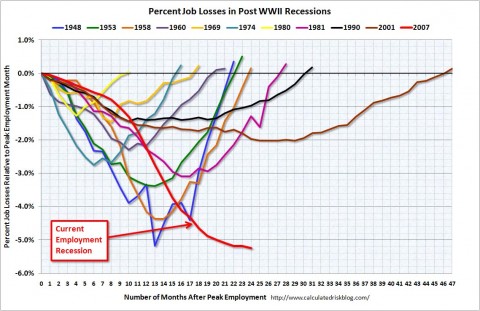November 19, 2010
National Data, By Edwin S. Rubenstein
Ian Fletcher (email him) is an Adjunct Fellow at the San Francisco office of U.S. Business and Industry Council, a Washington think tank. An economist with impeccable academic and private sector pedigrees—Columbia, University of Chicago, hedge funds, private equity groups—he is refreshingly, perhaps uniquely, skeptical of his profession. “We can’t trust the economists”, he writes, adding that while the public holds the economics profession in highest regard, “What economists say to the public is often very different from what they say to one another”
Fletcher has written an elegant, easy-to-read critique of one of the most cherished myths in economic theory—the supremacy of free trade. (Free Trade Doesn’t Work: What Should Replace It and Why, by Ian Fletcher, U.S. Business and Industry Council, 2010. 323 pages.)
by Ian Fletcher, U.S. Business and Industry Council, 2010. 323 pages.)
Fletcher believes that our chronic trade crisis stems from bad policies that mainstream economists told us were OK.
He is hardly the first to say this. Debunking free trade dogma has become a cottage industry in America, employing journalists, retired CEOs, and even a few economists whose paycheck does not come from a corporate beneficiary of free trade. But few bring Fletcher’s historical, psychological, and economic insights to this undertaking. (One hopes he will follow the free trade book with one on immigration or sub-prime mortgages.)
The theory of free trade originated with David Ricardo, a British economist of the early nineteenth century. He believed in two interrelated concepts: specialization and comparative advantage. According to Ricardo, each country should produce only those goods in which it excels—i.e. can make with comparatively less labor and capital than its trading partners—and import everything else. The theory implies that an advanced economy, say the United States, should import some goods from lower cost producers, say China, in order to free up our workforce to produce more valuable goods instead.
Advocates claim free trade is the natural state of affairs: Left to their own devices capitalists will achieve this international reallocation of production automatically. Their natural drive for profit steers them to the most valuable industry. Any policy other than free trade just saddles them with higher costs and fewer profits than they would otherwise incur.
But the public is blissfully unaware of the degree to which this theory full of holes. Enter Fletcher. He shines a laser beam on the unrealistic assumptions, dubious conclusions, and changing circumstances which, taken together, undermine the received free trade dogma.
In several chapters Fletcher lists and explains the fallacies underlying free trade. My selective, slightly modified version:


